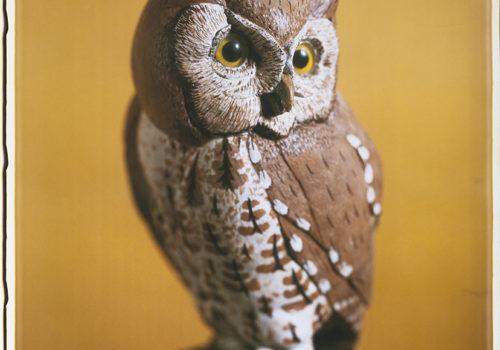Carré Chassé located on Chassé Veld (Chassé was a general, and the nearby barracks were named after him), and it is an excellent starting point for the indoor visits. It Unites a lot of projects, and the film projection shows selected videos.
You’ll also find a book shop with the festival catalogue and books by and about the artists at BredaPhoto. You can also catch your breath over a coffee and a snack.
Overhead in this space hang the imposing images of María Magdalena Campos-Pons (1959) (images 1-2), an artist from Cuba who lives and works in the US. She incorporates her kaleidoscopic background in her works, with a sense of self relatif humour.
Films will are projected on the ground floor, including the project Blood Bond (2024). Anaïs López (1981) (images 3-5) recounts the search for her exiled grandmother in her film Bloedband (Bloodties). What she thinks she knows, she has to re-examine, she finds and loses family members, and finally realises that truth is only the reflection of a point of view. A fascinating detective full of emotion. Besides Anaïs López’s project, 4 other films by Amber Dooms, Frédéric St-Hilaire & Jonathan Parant, Hira Nabi & Shaima Al-Tamimi are shown.
In Mercedes Matrix, Selma Selman (1991) (images 5-7) plays with the idea of mobility and the prestige of a car brand in her Roma community in Bosnia Herzegovina. During a performance full of references to The Matrix, the car comes under the axe (literally).
Sara Francola tries to come to terms with a destructive relationship in her series Delete, Delete, Delete (Images 8-9). The slow healing process is reflected in an installation where images from her archive are slowly destructed.
Margit Lukács (1973) & Persijn Broersen (1974) take us on a walk in the forest. Only Forest on Location (images 10 – 11) is a digital reconstruction of the primeval forest of Białowieża. Through photogrammetry, they reconstruct a 3D image of the nature we as humans are strongly estranged from. The artists present us with a multi-layered story with many facets: even the music refers to a stolen melody.
Sayuri Ichida (Japan, 1985) lives and works between the UK & the US presents us with one of the most thoughtful overall presentations. Using Ctrl-Shift-J (images 12-15), one switches on a computer between Western alphabet and Hiragana, a common Japanese writing system. The key combination similarly describes the feeling with which Ichida switches between the Japanese and Western worlds, hence the title of her project. Lines connect the images, which she then folds as to conform to their environment.
Poignant and topical is the contribution ‘I have no more earth to lose’ (images 16-18) by Sakir Khader (1990) a Palestinian documentary photographer and Magnum nominee (2024) who resides in the Netherlands. He won last year the ‘Zilveren Camera’, a prestigious photography prize. In this project, he documents the life of the Palestinian population in the West Bank, more specifically between the Jenin refugee Camp & Nablus. The gripping images and stories of children press the viewer into a cruel reality.
Thana Faroq (1990) How shall we greet the sun (images 19-20) explores the personal narratives and complex emotional landscape of the lives of a small group of young women refugees living in in the Netherlands. In her own words: ‘I spent the last two years documenting the aftermath that occurs after finding new soil to safely step on. … The struggle of inserting yourself into society with its rules and contradictions, that may or may not match what you used to know as safe. Those women are in a kind of archaeological restoration programme, where they try to build and construct a new life over the ruins of their past losses. ’
This project is also included in the exhibition at the City Gallery Grounding – Stories of Migration.
Adrianna Chlebicka Amongst the Amid (images 21-22) refers to the journey between a starting point and an ending point. Chlebicka prefers contemplative images, and in this series cuts up images from the family archive. The large collages translate her past into contemporary images, inviting the viewer to muse on parallel events.
Daryna Tyshchenko grew up in the shadow of the Russian threat, aggression, occupation of Ukraine. Her father died at the front, she became a refugee. She presents her collages under the title Wherever I go (images 23-24). They are a response to the suffering that befell her, an attempt to come to terms with her miseries and that of other refugees
In Blood is thicker than water (images 25-26), photographer Giany Kraan GIGI reflects on the importance we attach to blood. Metaphorically, it takes on the meaning of family, descent, belonging, us versus them. But what if descent becomes an impediment to success and acceptance? What if we start preferring the external features of the ‘other’, propagating an ideal of beauty that ignores our own identity?
Chassé Carré Chasséveld 3A Breda
Foto
Max Grund, Oscar Mack, Mónica Alcázar-Duarte, Sara Francola, Adrianna Chlebicka, Abdul Halik Azeez, Giany Kraan (GIGI), Oliwia Fit, Sakir Khader, Sayuri Ichida, Shaima Al-Tamimi, Daryna Tyshchenko, Margit Lukács & Persijn Broersen, Thana Faroq, Andrew Jackson, Selma Selman, Koral Carballo, María Magdalena Campos-Pons
Videoprojecten
Anaïs López, Amber Dooms, Frédéric St-Hilaire & Jonathan Parant, Hira Nabi & Shaima Al-Tamimi.
Opening hours
Tuesday – Sunday: 10:00 to 17:00 hours
Information point & ticket office, Café, Toilets, (Book)shop, Cinema
It is possible to park your car in parking garage Het Turfschip. This location is accessible for people in a wheelchair.
John Devos
[email protected]
















